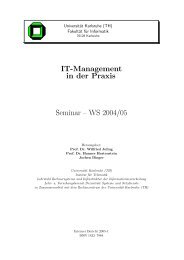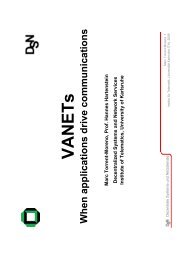Download PDF - KIT
Download PDF - KIT
Download PDF - KIT
You also want an ePaper? Increase the reach of your titles
YUMPU automatically turns print PDFs into web optimized ePapers that Google loves.
tracking accuracy. As mentioned in the beginning of this<br />
section, such a mechanism will help to reduce the congestion,<br />
but it does not control the congestion of the channel in the<br />
first place.<br />
Another example of congestion reduction can be found in<br />
[17]. The authors focus on emergency warning messages, that<br />
are sent whenever a vehicle shows an abnormal behavior (e.g.,<br />
it broke down and is blocking the road/lane, or it lost control<br />
and it is changing lanes unexpectedly). The authors aim of<br />
optimizing the transmission of warning messages is based on<br />
the observation that messages should be repeatedly sent out<br />
until the “abnormal” behavior stops and the vehicle returns to<br />
“normal” behavior. The authors further state that if several abnormal<br />
vehicles are sending out emergency warning messages<br />
at a constant rate, the average delivery delay will increase<br />
rapidly due to channel congestion. Consequently, the number<br />
of simultaneous emergency warning transmissions should be<br />
carefully controlled. To achieve this goal, the authors propose<br />
a “multiplicative rate decreasing algorithm”, which decreases<br />
the retransmission rate of an emergency warning message over<br />
time. As a result, several emergency warning messages can be<br />
served and delivered by the system with limited delay. The<br />
above transmission strategy is further optimized by defining<br />
strategies to freeze the generation of emergency messages<br />
when certain conditions are met (e.g., redundant transmissions<br />
from following vehicles).<br />
According to the terminology defined in Section III, the<br />
approach of [17] belongs to the class of proactive approaches,<br />
and acts on packet generation rate to prevent congestion. Yet,<br />
the approach of [17] is mostly an open-loop controller, since<br />
the multiplicative rate decreasing algorithm that is used to<br />
tune the packet generation rate is based only on predicted<br />
performance based on suitable models of the communication<br />
channel. On the other hand, a form of primary feedback (e.g.,<br />
reception of redundant transmissions from following vehicles)<br />
is used in the decision rules to freeze emergency message<br />
transmission.<br />
Apart from the cited studies above, other congestion reduction<br />
solutions that adapt the transmission power and generation<br />
rate based on the current velocity exist as well (e.g. [18],<br />
[19]). Since the paper focuses on actual congestion control<br />
techniques, we will skip their detailed presentation here and<br />
instead survey a collection of representative congestion control<br />
approaches for cooperative vehicular systems. One of these<br />
approaches, called Distributed Fair Power Adjustment for<br />
Vehicular Environments or D-FPAV [20], will be described<br />
in detail in the next section.<br />
On the reactive side of congestion control, Khorakhun et. al<br />
developed an algorithm that adjusts either the transmission<br />
power or the packet generation rate with relation to the locally<br />
measured channel busy time ratio [21]. The channel busy time<br />
is the fraction of time during which the channel was sensed<br />
busy. Depending on whether the local measurement is below<br />
or above a pre-defined threshold, the transmission power or<br />
generation rate is either increased or decreased by one step.<br />
In order to achieve a higher level of fairness, the authors stated<br />
that it is necessary to exchange the local measurements among<br />
neighboring vehicles, and allow an increase of the transmission<br />
power/rate only if the currently used value is below the average<br />
power/rate configuration used by the vehicle’s neighbors.<br />
Compared with proactive approaches, this reactive approach<br />
is not able to avoid congestion on the wireless channel, and<br />
supports no prioritization of different classes of messages. In<br />
addition, a simple analysis shows that the proposed algorithm<br />
is not able to prevent oscillations in the adjustment process.<br />
The issue is systematic and fundamental: since not all vehicles<br />
perform the transmit power adjustment at the same point in<br />
time, it can easily happen that the transmit power reduction at<br />
a few nodes leads to a reduced channel busy time observation<br />
from the perspective of neighboring nodes that have yet not<br />
reduced their transmit power. As a result, those nodes will<br />
possibly increase their transmit power (instead of decreasing<br />
it as well), and amplify the transmit power reduction of nodes<br />
that have already decreased their transmit power. It is obvious<br />
that some sort of additional feedback is needed to indicate the<br />
reason why the measured channel busy time has decreased or<br />
to determine who should reduce first.<br />
A hybrid approach that attempts to combine the advantages<br />
of both proactive and reactive approaches was proposed by<br />
Baldessari et. al in [22]. Their solution consists of an improved<br />
rate control, an improved power control and a combined<br />
power and rate control algorithm, all of which use channel<br />
busy time observations to derive the number of neighbors in<br />
the surrounding area (optionally, also through an additional<br />
exchange of local vehicle density estimations). Based on the<br />
number of neighbors and a pre-defined channel busy time<br />
threshold, the authors then either derive a packet generation<br />
rate directly, or start with a fixed packet generation rate and<br />
derive the maximum transmission power which will not violate<br />
the threshold. In the latter case, the authors assume that the<br />
vehicles in the surrounding area are distributed uniformly and,<br />
typical for a proactive approach, make use of a communication<br />
model that maps carrier sense ranges to individual transmission<br />
power levels.<br />
Another hybrid congestion control approach was recently<br />
proposed in [23], where the authors adaptively change both<br />
beacon generation rate (in a proactive way) and transmission<br />
power (in a reactive way) with the goal of reducing channel<br />
congestion, and consequently improving a vehicle’s ability to<br />
accurately track the position of surrounding vehicles. Two<br />
slightly different control approaches are applied to the tuning<br />
of beacon generation rate and transmission power. Beacon<br />
generation rate is tuned based on a predicted tracking error<br />
of own position. The prediction accounts for channel<br />
unreliability, i.e. packet losses, by including the observed<br />
fraction of successfully received beacons sent by surrounding<br />
vehicles. Thus, a closed-loop feedforward controller based on<br />
secondary feedback is used for setting the beacon generation<br />
rate. Additionally, transmission power control is applied based<br />
on the observed channel status (more specifically, based on the<br />
channel busy time). This part of the algorithm is thus a closedloop<br />
feedback controller based on secondary feedback. Note<br />
that both beacon generation rate and transmission power use<br />
information locally available at the vehicles (i.e., direct observations)<br />
to control transmission parameters. As a consequence,<br />
this mechanism bears the same fundamental issue observed for<br />
6




